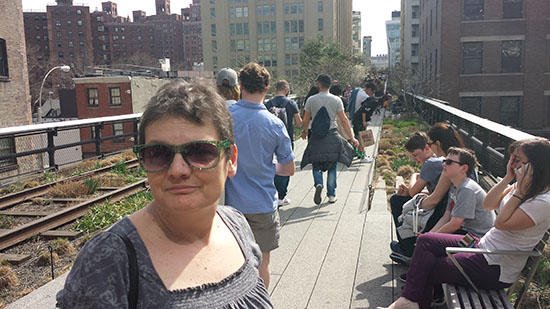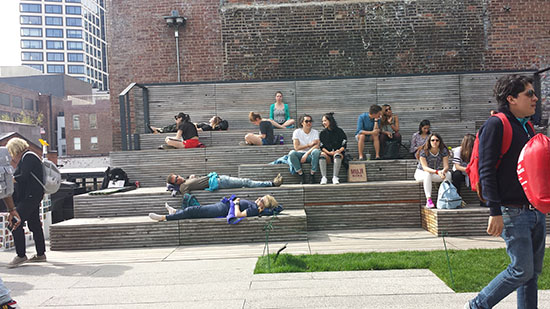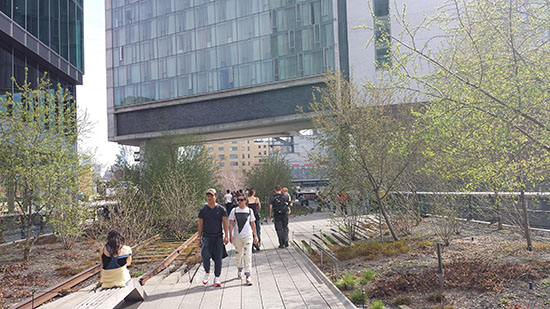By Ron Hine | FBW | April 12, 2017
On Tuesday afternoon, April 11, my partner Laurie Brongo and I walked the High Line. We took the ferry from Hoboken to midtown Manhattan, then walked to the southern border of what was once called Hell’s Kitchen. Now unrecognizable as that former gritty neighborhood, the northern terminus of the High Line at West 34th Street offers stunning, close-up views of the massive towers under construction at Hudson Yards over the Metropolitan Transportation Authority’s West Side Yard, which claims to be the largest private real estate development in the history of the United States.
As always, people from all over the world were out in force along the highline (as evidenced by the various languages overheard), a testament to the remarkable popularity of this unique public space. As a former freight rail line, The High Line provides an unusual vantage point, bisecting city blocks from the center and elevating the walker above the hubbub of Manhattan’s commercial avenues.
The High Line’s history is instructive for citizen activists. As the interstate trucking industry flourished through the 1970s, freight rail declined, and in fact, the last train on the High Line ran in 1980. Few could see any potential for the site. Property owners and the City of New York lobbied to destroy it, and in fact succeeded in tearing down the entire section from Gansevoort Street down to St. John’s Park Terminal at Spring Street.
But in 1982, local activist and railroad buff Peter Obletz first explored the High Line, climbing a set of stairs to the top of the tracks. Immediately, he saw the site’s potential. At that time, he told a New York Times reporter, “It was a terra incognita up there . . . Unrestricted space. Unimaginable tranquility.” Mr. Obletz challenged the demolition of the High Line. In 1984, he bought the abandoned rail line from Conrail for $10 and then spent all his financial resources defending his title in court, where he ultimately failed.
In 1999, New York City Chelsea residents Joshua David and Robert Hammond, inspired by an elevated urban rail line in Paris that became a 3-mile elevated park, The Promenade Plantee, founded Friends of the High Line, building upon the tenacious campaign started by Mr. Obletz.
For years, the nonprofit Friends of the High Line persevered in its mission to convert the elevated railway to public open space and make it part of New York City’s park system. They succeeded not only in building community support but also in raising tens of millions of dollars in private funds for its construction. By 2004, recognizing a once in a lifetime opportunity to create a truly innovative, elevated linear park, New York City Mayor Michael Bloomberg committed the City to the project, initiating competitions for its design.
In November 2005, the City of New York accepted ownership of the High Line through a donation by CSX Transportation. Groundbreaking occurred in April 2006, and by 2009, segments of the High Line were opened up to the public. Today, the park is nearly complete save for a western spur that is scheduled to open this year. Most of the maintenance for the park is provided privately through the Friends of the High Line.
The remarkable landscaping along the highline is the work of the influential Dutch garden designer and nurseryman, Piet Oudolf. On our early April walk, some of the bulbs had just begun to flower and the young leaves of the shrubs and trees were only starting to emerge. Known for using bold drifts of herbaceous perennials and grasses, Oudolf was inspired by the tallgrass prairies of the American Great Plains, and in fact, a section of the High Line is dubbed the Chelsea Grasslands. We vowed to return in several months to enjoy the full beauty of the High Line’s landscape plan.
The unique and tasteful design elements of the High Line have a consistency throughout, helping to unify this linear park. The historic railroad tracks have been preserved for much of the way, and the decorative concrete planks that form the walking path undulate between the planted areas. Wooden benches and other seating areas, mostly occupied during our walk, seem to spring up organically from the pathway. There is a playfulness to much of the design that engages both young and old.
We walked the entire mile-and-a-half length, ending at Gansevoort Street near Little West 12th, disappointed that the journey ended there instead of at the rail line’s original starting point on Spring Street. Descending the stairs, we witnessed the former meatpacking district transformed: shops, restaurants and bars were opening up in the old, former industrial buildings. We ducked into the Standard Biergarten below the High Line to enjoy an ale and marvel at the massive steel structure that supported this linear park. Clearly, the five million visitors who walk the High Line annually provide a great stimulus to the business community that lines the route.

Laurie joins the crowds along the High Line.

The High Line utilizes consistent and unique designs for its benches, lounge chairs and other seating areas for the entire length of this linear park.

The High Line, which is routed through the middle of blocks, rather than above the City’s streets, here passes under a residential building.
The similarities to Hoboken did not go unnoticed. The linear waterfront park proposed for Hoboken’s Hudson riverfront was an idea promoted by local civic-minded residents via the Fund for a Better Waterfront (FBW) beginning in 1990. The waterfront referenda in 1990 and 1992 that defeated the original City of Hoboken/Port Authority development pitted ordinary citizens against nearly every elected official and the entire political system. In 1990, Hoboken’s waterfront, like New York’s rail line, had been virtually abandoned by the maritime industries that once dominated the Hudson’s shoreline.
Similarly, The City of Hoboken failed to see the potential that lay in this derelict, waterfront wasteland. Dedicated citizens, however, with the aid of professional planners, architects and landscape architects, did recognize an opportunity, and began to make their vision into reality with a plan. The contiguous, public linear park at Hoboken’s South Waterfront plus the upland development and lively streetscape has brought life and activity to this formerly comatose part of town. Much like the High Line, a key element of the vision for a linear park in Hoboken is that it be unquestionably public, free from private interests or buildings intruding on the park. The Hoboken park, however, is not complete. FBW continues to pursue the vision of a contiguous, connected greenway along Hoboken’s Hudson riverfront.
Related Links
The Charming Gadfly Who Saved the High Line NY Times May 2007
Plan for the Hoboken Waterfront
What do Zuccotti Park and Hudson River Waterfront Walkway have in common?
Jane Jacobs helps explain what makes a better waterfront
William H. Whyte on what makes public spaces fail and what makes them succeed
